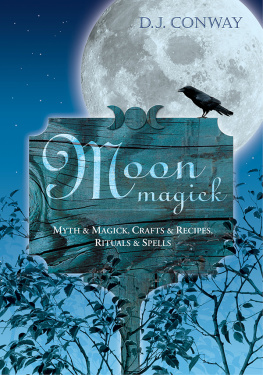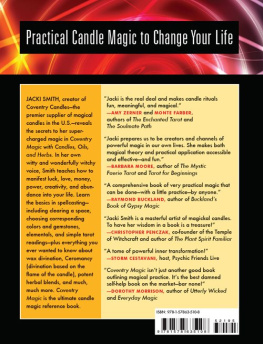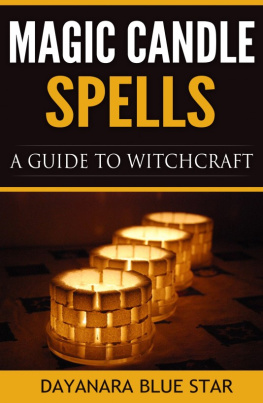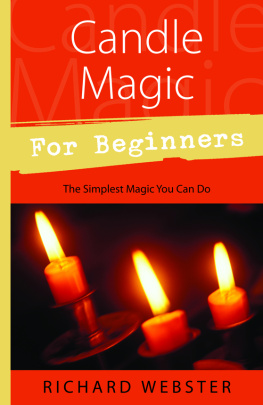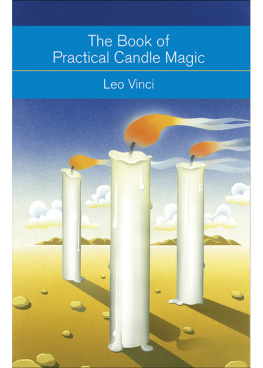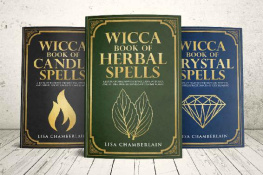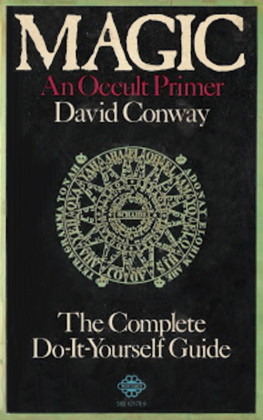D.J. Conway - A Little Book of Candle Magic
Here you can read online D.J. Conway - A Little Book of Candle Magic full text of the book (entire story) in english for free. Download pdf and epub, get meaning, cover and reviews about this ebook. year: 2011, publisher: Clarkson Potter/Ten Speed, genre: Science fiction. Description of the work, (preface) as well as reviews are available. Best literature library LitArk.com created for fans of good reading and offers a wide selection of genres:
Romance novel
Science fiction
Adventure
Detective
Science
History
Home and family
Prose
Art
Politics
Computer
Non-fiction
Religion
Business
Children
Humor
Choose a favorite category and find really read worthwhile books. Enjoy immersion in the world of imagination, feel the emotions of the characters or learn something new for yourself, make an fascinating discovery.

- Book:A Little Book of Candle Magic
- Author:
- Publisher:Clarkson Potter/Ten Speed
- Genre:
- Year:2011
- Rating:5 / 5
- Favourites:Add to favourites
- Your mark:
- 100
- 1
- 2
- 3
- 4
- 5
A Little Book of Candle Magic: summary, description and annotation
We offer to read an annotation, description, summary or preface (depends on what the author of the book "A Little Book of Candle Magic" wrote himself). If you haven't found the necessary information about the book — write in the comments, we will try to find it.
D.J. Conway: author's other books
Who wrote A Little Book of Candle Magic? Find out the surname, the name of the author of the book and a list of all author's works by series.
A Little Book of Candle Magic — read online for free the complete book (whole text) full work
Below is the text of the book, divided by pages. System saving the place of the last page read, allows you to conveniently read the book "A Little Book of Candle Magic" online for free, without having to search again every time where you left off. Put a bookmark, and you can go to the page where you finished reading at any time.
Font size:
Interval:
Bookmark:
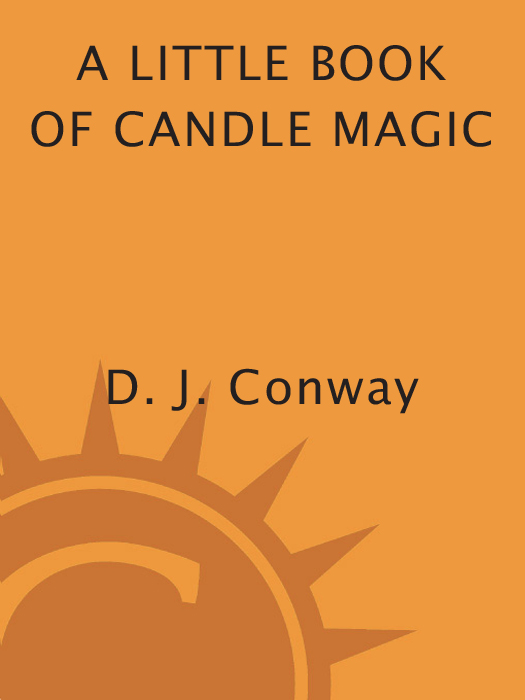
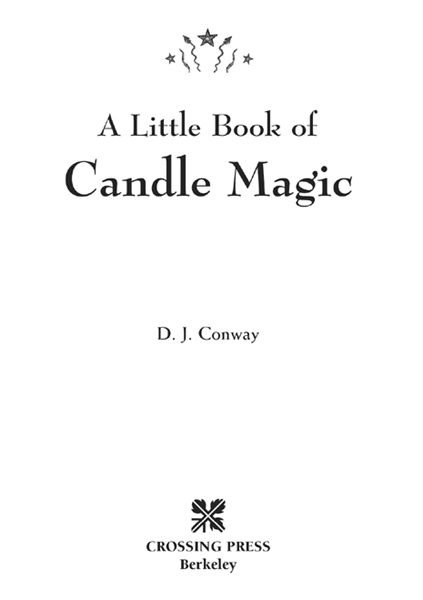
Text copyright 2000 by D. J. Conway
All rights reserved. Published in the United States by Crossing Press, an imprint of the Crown Publishing Group, a division of Random House, Inc., New York.
www.crownpublishing.com
www.tenspeed.com
Crossing Press and the Crossing Press colophon are registered trademarks of Random House, Inc.
Library of Congress Cataloging-in-Publication Data
Conway, D. J. (Deanna J.)
A little book of candle magic / by D. J. Conway.
p. cm.
1. Candles and lightsMiscellania 2. Magic. I. Title.
BF1623.C26 C66 2000
133.2dc21 99-057495
eISBN: 978-0-307-78582-4
v3.1

H umankind has always held a deep respect for fire and its power. This respect for and curiosity about fire probably began when humans first became brave enough to take fires caused by lightning back to their camping places to use for warmth and cooking. Some archaeologists place this occurring about 250,000 to 500,000 years ago. Until humans learned how to start fires on their own, these early people were very careful to keep such captured, sacred fire burning at all times.
It was not long before humans discovered that fire had two aspects: the sacred and the mundane. Shamans kindled their fires in specific ways with special woods. They used this fire to light mysterious caves and sacred power sites that only certain people entered for mystical rituals. These holy fires helped the shaman and other initiated participants connect with the spiritual worlds where they received messages and first learned healing and magic. Later, they learned other secrets, such as metalworking. Because fire could be either creative or destructive, those who handled fire were considered to be divinely touched.
Early myths and legends tell of various divine beings who either stole fire from heaven, as Prometheus did, or who gave this wonderful gift to humans so they could survive and worship the deities. Many deities from cultures around the world are associated with fire in one or more of its forms, such as the hearth, volcanoes, and lightning.
Much later in their history, humans developed more portable forms for using sacred fires. First came the torch, then the oil lamp and candles. All holy places were lit by these miniature forms of fire, as were private home altars. Priests and magicians taught that the flame of oil lamps and candles represented the spirits highest potential and that the smoke carried the worshippers prayers and desires into the spiritual realm.
Herbs were either burned as incense or added to the candles. The herbs not only gave off a pleasant scent, but also often were chosen for their ability to trigger altered states that led the priest or magician into a higher state of consciousness. Accompanied by prayer, chants, dance, and/or deep concentration, the priests and magicians learned that they could manifest their desires. Thus, magic was discovered.
Magic continued to thrive and be accepted as a viable method for making life better until much later, when religions declared that magic was not possible and was only superstitious nonsense. However, these same religions continued to light their sacred places with the holy flame in one form or another.
Even today, fire rituals are still used in many cultures and religions around the world. Nearly every religion uses candles, lamps, or incense to mark their religious centers and ceremonies.
In Latin America, people still use candles to mark Halloween. They prepare an altar or a gravesite with pictures of departed loved ones and light candles that represent the spirits of the dead. In the United States and Europe, people celebrate this same seasonal festival with candles inside hollowed-out pumpkins; however, these candles are to chase away spirits, not honor them.
The Catholic religion uses an ever-burning flame, hung above the altar, to alert worshippers of the presence of the communion host. Catholic churches also have racks of votive candles, which can be lit by those presenting petitions and desires to Mary or one of the saints. Devotional candles are very popular with the worshippers of several religions. These lights may be in the form of votive, taper, or novena candles, which are offered to a particular saint, deity, or Loa (a deity in certain African religions) in a petition for their help.
To mark birthdays, several cultures use a tall candle measured into twenty-one segments. This candle is blessed and lit on the first birthday of a child. Then, it is relit on each consecutive birthday and allowed to burn down to a mark; this is repeated until the child turns twenty-one. This is enacted in the form of a petition to a deity so that the child may have a happy, healthy life. The candles commonly placed on top of a birthday cake have much the same meaning.
As far back as very ancient history, funerals have also used fire in many forms. Cremation was believed to release the soul immediately into the afterworld. Torches and candles often lined a processional path to the burial site or place of cremation, symbolically guiding the soul to the invisible door that led to Valhalla, heaven, or whatever the culture believed to be the otherworld.
Likewise, candles are often used at weddings, this time with a different connotation. The flame of the candles traditionally signals the presence of deities who will bless the union, as well as remind the bride and groom that the element of spirit should be present in the marriage.
Hanukkah is a Jewish festival known also as the Feast of Dedication or the Festival of Lights. It commemorates the victory of the Maccabees over the Syrian Greeks. The Talmud says that after the Temple was cleansed and rededicated, only one small cruse of holy oil was found to use for relighting the perpetual fire. Miraculously, this oil burned for eight days. Today, this festival is marked by lighting one candle each day, until eight candles are lit.
Another tradition found in several cultures says that when a house has known happiness and prosperity, then that dwelling is inhabited by a good spirit. When the family moves, they can carry this spirit with them by lighting a large candle from the hearth. The hearth in the new home is then lit from this candle, thus providing a welcome for the good spirit.
Several Yule or Christmas customs also use the sacred flame, although we have forgotten much of the significance behind these seasonal rituals. The lights on the modern Christmas tree have replaced the candles once used to signify rebirth. The electric light in the window was at one time a candle that helped departed loved ones return to join in the festivities. The Yule log in the fireplace symbolizes the death of the old year and the birth of the new year; it also represents the old tradition of the rebirth of the sun.
In a great many public gatherings, you will see people holding candles. Known as vigilance candles, these are used to remember a specific person or event and to create unity and change. Little do these participants realize that they are performing a type of magic. This multitude of candles actually directs the peoples spiritual energy to a desired goal.
Why are candles still so popular? I believe it is because of genetic memories that lie buried deep within the superconscious mind of every human. These memories call to us over the distance of centuries; they affect our subconscious responses to life. Fire has always been sacred. Genetic memories remind us that it still is. In response, we are drawn to candles, whether we use them in ritual or simply light them on a birthday cake or the table for a special dinner.
Font size:
Interval:
Bookmark:
Similar books «A Little Book of Candle Magic»
Look at similar books to A Little Book of Candle Magic. We have selected literature similar in name and meaning in the hope of providing readers with more options to find new, interesting, not yet read works.
Discussion, reviews of the book A Little Book of Candle Magic and just readers' own opinions. Leave your comments, write what you think about the work, its meaning or the main characters. Specify what exactly you liked and what you didn't like, and why you think so.

